These days I’m using two fairly well-known tools from the world of design thinking, lean startup, entrepreneurship, or more broadly from the agile world: action plan mapping, or tactical mapping, and strategy mapping. That is user story mapping and impact mapping. I had already extensively covered these tools through various articles but a) I need and want to clarify my point with articles b) my practice has continued to evolve since the previous articles. So I’m going to try a short series (5 articles?) on these mappings. A presentation of action plan mapping, user story mapping, then a presentation of an example of diverted, twisted, but useful use for example around a roadmap. A presentation of strategy mapping, impact mapping, then a presentation of a variation that calls upon its cousin the strategy map and OKRs from management 3.0. Finally an article on the eminently useful marriage of these two approaches, one enriching the other.
ps: this is not Jeff Patton’s user story mapping to the letter. For example I don’t use “personas”. You can read Patton’s book, it’s good, funny, cheeky, and the first 90 pages are enough, the others are just repetitions to make a book.
What is it for?
Action plan mapping is about defining the… action plan. That is tactically (operationally, on the ground, in the mud, hands dirty), how we’re going to concretely implement our strategy, our idea. Generally it’s dedicated to the creation of a product or an offer. The objective is to break down into small pieces that make sense to quickly have something that allows us to learn and/or benefit from our realization as soon as possible. If we are able to order by value, and thus deliver in small pieces that make sense, we have effective risk management. Either we fail quickly and minimize the costs/investment of this learning, or it’s a success and the risk diminishes or disappears, and we can benefit early from our efforts.
I can repeat here Jeff Patton’s beautiful maxim: “Minimize effort, maximize results”.
Action plan mapping, user story mapping, is done in workshops of several hours, in several sessions depending on the scope, ideally with the people impacted by the idea, the product, both those who carry the need and those who will realize it. Each one feeds the other. A large wall or a large table are indispensable.
Step 1: Determine your story and its chapters
Action plan mapping is first and foremost a story. The story of your product, your idea, your feature, your strategy. A story chapter after chapter therefore with a chronological approach. This chronology can be logical: I send out invitations to my big party after having found the right venue. As this chronology could be based on importance, a strategic approach: I decide to launch a community around dogs: we’re first going to offer group walks, then pet sitting, then expert advice, finally we’ll be able to sell derivative products around this community.
If I express things in the form of a story I clarify my thinking, and I communicate it much better. People project themselves into it much better, they memorize much better (22x better they say when you’re able to tell stories).
So I start by building a backbone that articulates around the chapters of my story. (As always in these workshops: if we forget something we can add it later). We should push the person in charge to tell their story out loud by going through these chapters from left to right.
Color codes are our friends. We’re going to try to define a color for this backbone. White let’s say. The simplest, A4 pages cut in half. Let’s be practical.
I’m taking up here my favorite “peetic”: a matchmaking site for pet owners (cats & dogs) that will allow me to sell derivative products. My story: “I first have an owner who therefore has a pet, they save time and socialize by going on walks, by making walks happen, or by having adapted pet sitting through exchange (there they can even go on vacation), finally they’re delighted because their pet is doing well thanks to the advice provided by the service, thus with our subscribers we’re going to be able to start doing advertising then sell derivative products through the shop”. This story will emerge from the impact mapping that I’ll present to you later. It could have been more micro: “I browse the products in the catalog, I put products in my cart, I take advantage of promotions, I must register as a user, then I pay, finally I consult my orders and my invoices”.

Step 2: Determine the components of your chapters
When the first step is completed we take chapter by chapter and we try vertically, in column mode, to place all the necessary components for the proper realization of the chapter. It’s simple. Element by element. But action plan mapping, user story mapping, is simple. The black slope in the image above is when things seem impossible we attack them step by step. Damn I’m quoting a part of Descartes’ method). But where I diverge from Descartes: a small set of elements is enough to make sense (we’re not looking for entirety, completeness), we start with what has the most value (and not the easiest in the gentleman’s Method).
We use the yellow color code? Stickers?
Here’s a small action plan mapping, a small user story map, you can have very large ones… (still peetic).
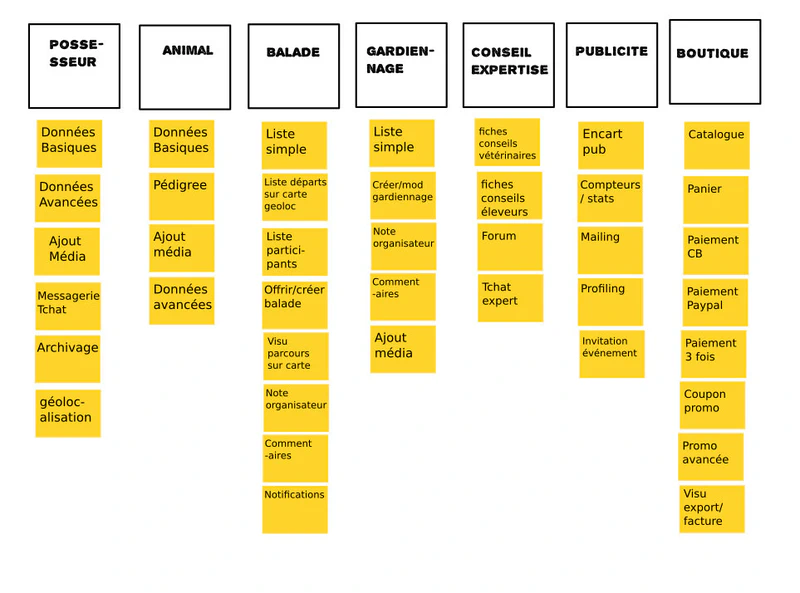
Step 3: Points of vigilance
Determining the components of chapters is often the opportunity to involve everyone, the opportunity for discussions, reflections, the opportunity to say aloud the points of vigilance. Often dependencies with other groups, unknowns. We’re not going to forget them, we’re going to place a sticker, a post-it.
The color code? Red or pink, it’s still a point of vigilance. If the same point appears twice, just note it once, the furthest left, in the order of the story.
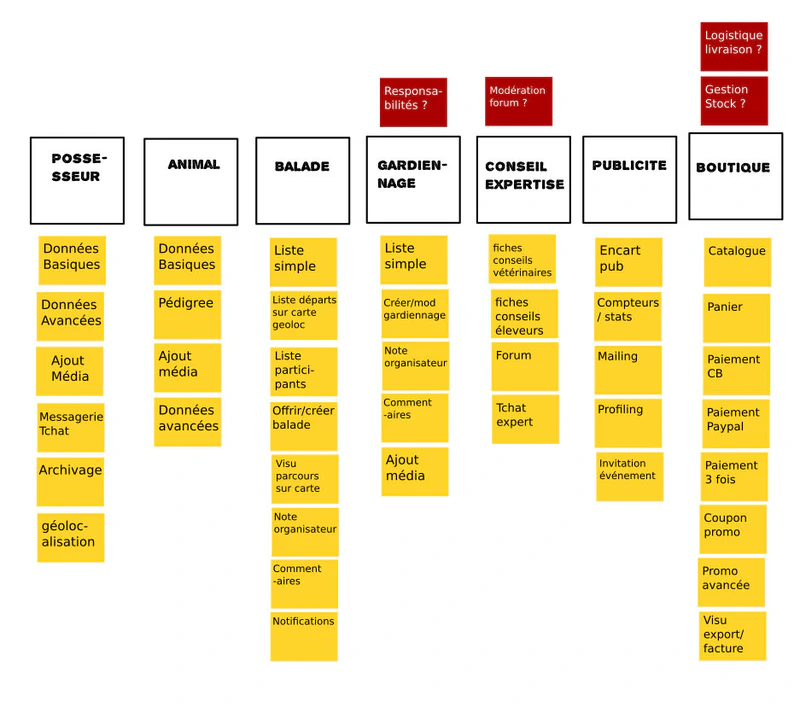
Step 4: Define a first ordering by value per column
More difficult exercise for the need bearer: we’re now going to ask them to prioritize by importance, by value, the elements within each column, column by column. They will still have to take into account dependencies: I’m not going to send my invitations before having the guest list for my mega party…although… in any case I first need a beginning of a list before sending anything. So the need bearer(s) order by value (and potentially they are subject to dependencies) the elements of each chapter. At the top the components with the most value, the most important, those that interest us the most, those that make us learn the most.
At any time elements can appear, disappear, change, over the course of the conversation, no problem, you integrate them in the right place.
(click to enlarge)
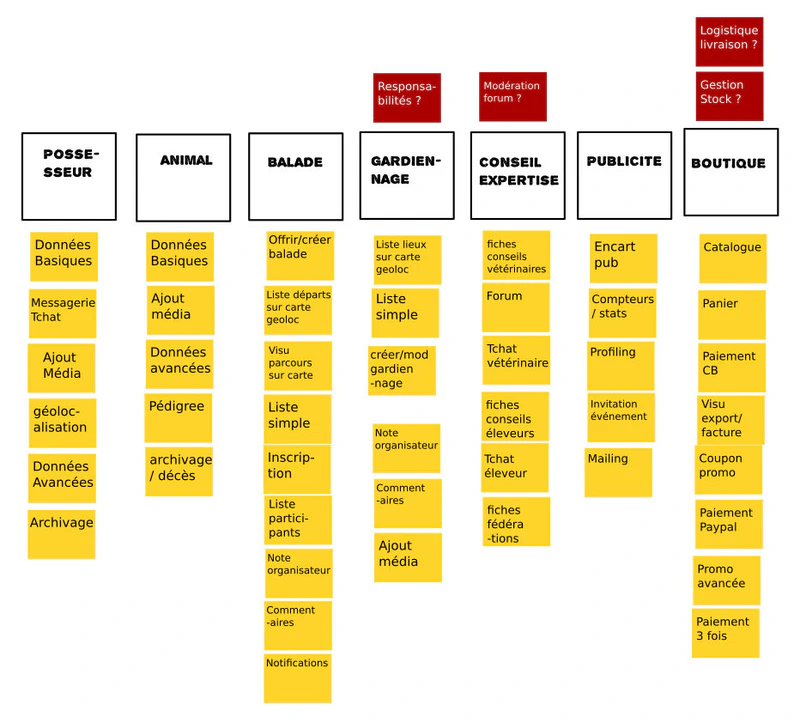
Step 5: Define a second fairly global ordering
Now we have a fairly complete mapping. It’s time to add relief. We’re going to add a column on the left to place a scale there. This scale should be importance, value. We can’t envision too fine a scale, so we’re going to imagine three or four levels. You could call these levels MoSCoW: Must (mandatory), Should (we should do that), Could (we could do that), Won’t or Would depending on the context (Is it useful to do that? We don’t do it? or We would like to do that but is it important?). But this can block some need bearers: “What do you mean but everything is mandatory” (yes yes that’s right…). You can then call these steps “batch 1, batch 2…”, “stage 1”, “stage 2”, but that implies completeness yet we must imagine that we only do “batch 1” or “stage 1” and that it could be self-sufficient. Try your best we’ll come back to these labels at the end of the journey thanks to Dragos.
In any case: a) it’s often a difficult act for need bearers, b) something interesting should emerge visually.
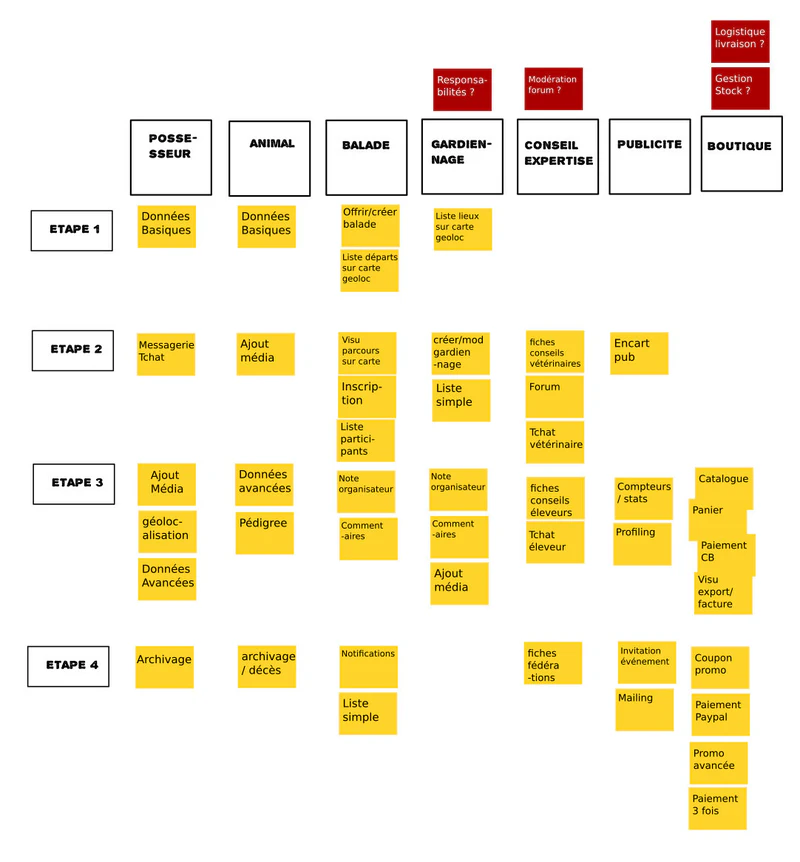
Step 6: Slide your need bearers into discomfort
In product management, in managing many projects, many activities, the complex changing world in which we live requires us to quickly validate our hypotheses, because all these weightings, prioritizations, all this value, remain hypotheses. Hypotheses to validate, and in our risk management, our effort, our investments, to validate as quickly as possible.
You will have noticed that need bearers often balk at moving elements down to lower priorities. What could be more normal. Yet we should dare to put ourselves in discomfort to validate quickly. Difficult to push them into discomfort unless… you free up space for a horizontal line, a new level, above the others, on which you could write: “it hurts but it works”, implying “ouch it’s really the bare minimum I don’t feel comfortable but indeed it would already validate my first and most important hypotheses, components”.
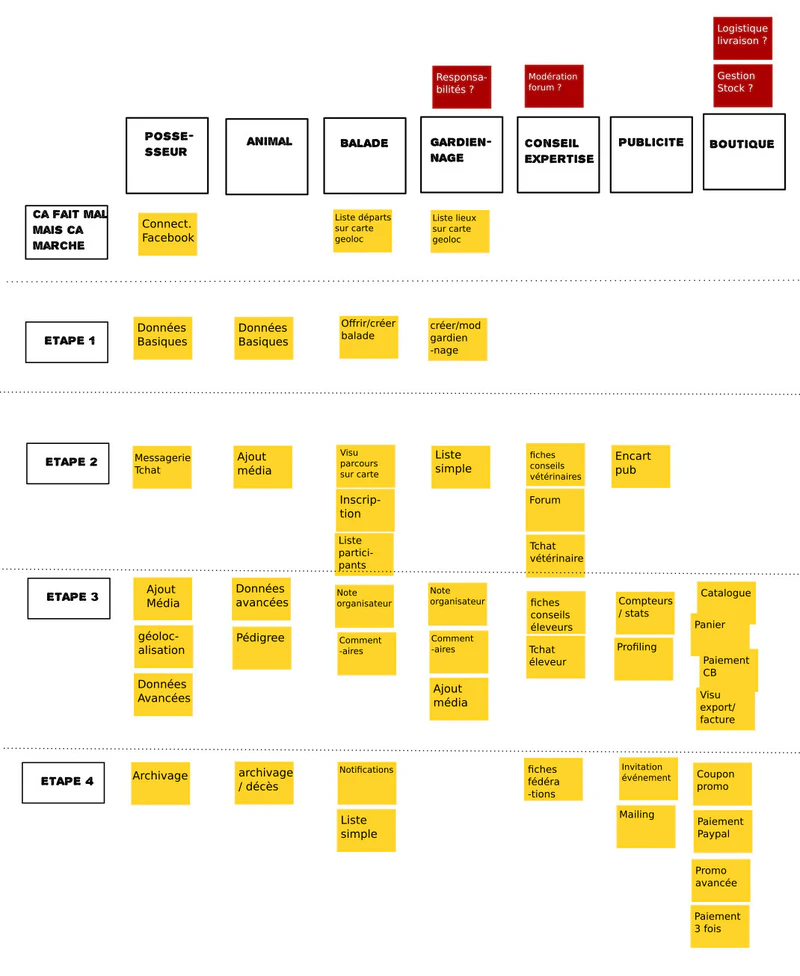
Step 7: Define the stories within the story
For this relief to make even more sense I add a final touch, the Dragos ’s touch, the sense man par excellence (sometimes he should do incoherent things to see). Try to transform your left column titles (Must, Should, … Batch 1, Batch 2…, Stage 1, Stage 2…) into sentences telling small stories. Give coherence to your subsets. This delivers a very interesting reading grid that can push you to move a few more stickers/post-its. No problem.
Story #1: opening with Facebook connection that allows knowing about walks or pet sitting between owners. We collect the information ourselves.
Story #2: we reintegrate users into our system and allow dynamic creation of community offers for walks or pet sitting.
Story #3: we launch expert advice and a first ad (monetization).
Story #4: we expand and launch the shop.
Story #5: let’s not dream we’ll have other ideas before these ones.
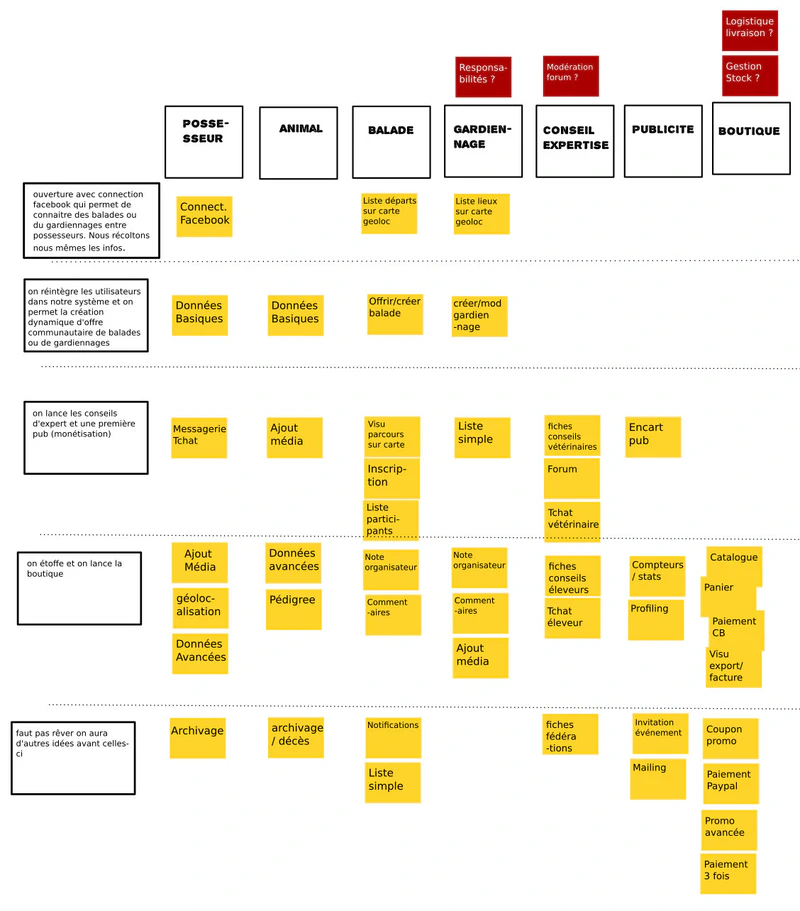
Beware the sum of effort per stage is not necessarily the same! We mainly want to identify a tactical approach that allows breaking down into meaningful and small stories (especially at the beginning) to quickly validate our hypotheses.
Next time I’ll twist action plan mapping, a user story map, to use it as a roadmap tool, project portfolio, among other examples.